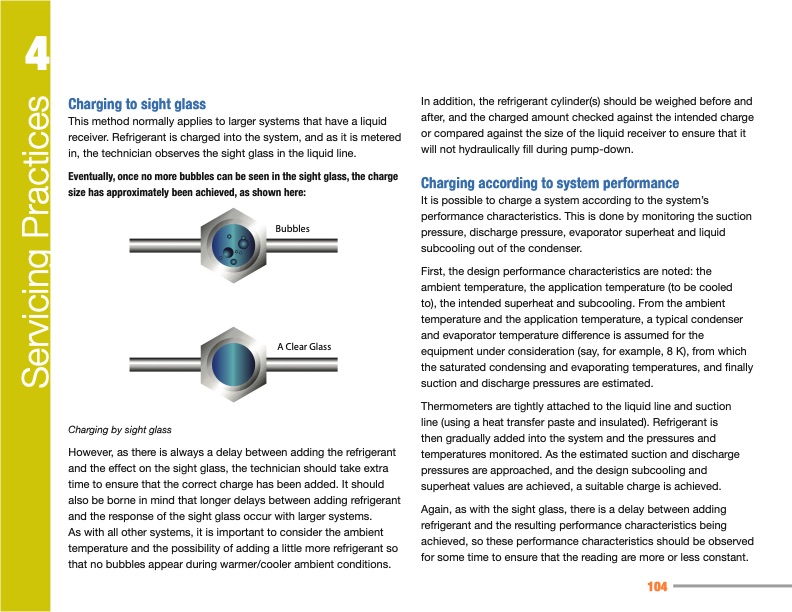
PDF Publication Title:
Text from PDF Page: 104
4 Charging to sight glass This method normally applies to larger systems that have a liquid receiver. Refrigerant is charged into the system, and as it is metered in, the technician observes the sight glass in the liquid line. Eventually, once no more bubbles can be seen in the sight glass, the charge size has approximately been achieved, as shown here: In addition, the refrigerant cylinder(s) should be weighed before and after, and the charged amount checked against the intended charge or compared against the size of the liquid receiver to ensure that it will not hydraulically fill during pump-down. Charging according to system performance It is possible to charge a system according to the system’s performance characteristics. This is done by monitoring the suction pressure, discharge pressure, evaporator superheat and liquid subcooling out of the condenser. First, the design performance characteristics are noted: the ambient temperature, the application temperature (to be cooled to), the intended superheat and subcooling. From the ambient temperature and the application temperature, a typical condenser and evaporator temperature difference is assumed for the equipment under consideration (say, for example, 8 K), from which the saturated condensing and evaporating temperatures, and finally suction and discharge pressures are estimated. Thermometers are tightly attached to the liquid line and suction line (using a heat transfer paste and insulated). Refrigerant is then gradually added into the system and the pressures and temperatures monitored. As the estimated suction and discharge pressures are approached, and the design subcooling and superheat values are achieved, a suitable charge is achieved. Again, as with the sight glass, there is a delay between adding refrigerant and the resulting performance characteristics being achieved, so these performance characteristics should be observed for some time to ensure that the reading are more or less constant. Charging by sight glass However, as there is always a delay between adding the refrigerant and the effect on the sight glass, the technician should take extra time to ensure that the correct charge has been added. It should also be borne in mind that longer delays between adding refrigerant and the response of the sight glass occur with larger systems. As with all other systems, it is important to consider the ambient temperature and the possibility of adding a little more refrigerant so that no bubbles appear during warmer/cooler ambient conditions. Bubbles A Clear Glass 104 Servicing PracticesPDF Image | Manual for Refrigeration Servicing Technicians

PDF Search Title:
Manual for Refrigeration Servicing TechniciansOriginal File Name Searched:
Refrigeration_Servicing.pdfDIY PDF Search: Google It | Yahoo | Bing
NFT (Non Fungible Token): Buy our tech, design, development or system NFT and become part of our tech NFT network... More Info
IT XR Project Redstone NFT Available for Sale: NFT for high tech turbine design with one part 3D printed counter-rotating energy turbine. Be part of the future with this NFT. Can be bought and sold but only one design NFT exists. Royalties go to the developer (Infinity) to keep enhancing design and applications... More Info
Infinity Turbine IT XR Project Redstone Design: NFT for sale... NFT for high tech turbine design with one part 3D printed counter-rotating energy turbine. Includes all rights to this turbine design, including license for Fluid Handling Block I and II for the turbine assembly and housing. The NFT includes the blueprints (cad/cam), revenue streams, and all future development of the IT XR Project Redstone... More Info
Infinity Turbine ROT Radial Outflow Turbine 24 Design and Worldwide Rights: NFT for sale... NFT for the ROT 24 energy turbine. Be part of the future with this NFT. This design can be bought and sold but only one design NFT exists. You may manufacture the unit, or get the revenues from its sale from Infinity Turbine. Royalties go to the developer (Infinity) to keep enhancing design and applications... More Info
Infinity Supercritical CO2 10 Liter Extractor Design and Worldwide Rights: The Infinity Supercritical 10L CO2 extractor is for botanical oil extraction, which is rich in terpenes and can produce shelf ready full spectrum oil. With over 5 years of development, this industry leader mature extractor machine has been sold since 2015 and is part of many profitable businesses. The process can also be used for electrowinning, e-waste recycling, and lithium battery recycling, gold mining electronic wastes, precious metals. CO2 can also be used in a reverse fuel cell with nafion to make a gas-to-liquids fuel, such as methanol, ethanol and butanol or ethylene. Supercritical CO2 has also been used for treating nafion to make it more effective catalyst. This NFT is for the purchase of worldwide rights which includes the design. More Info
NFT (Non Fungible Token): Buy our tech, design, development or system NFT and become part of our tech NFT network... More Info
Infinity Turbine Products: Special for this month, any plans are $10,000 for complete Cad/Cam blueprints. License is for one build. Try before you buy a production license. May pay by Bitcoin or other Crypto. Products Page... More Info
| CONTACT TEL: 608-238-6001 Email: greg@infinityturbine.com | RSS | AMP |